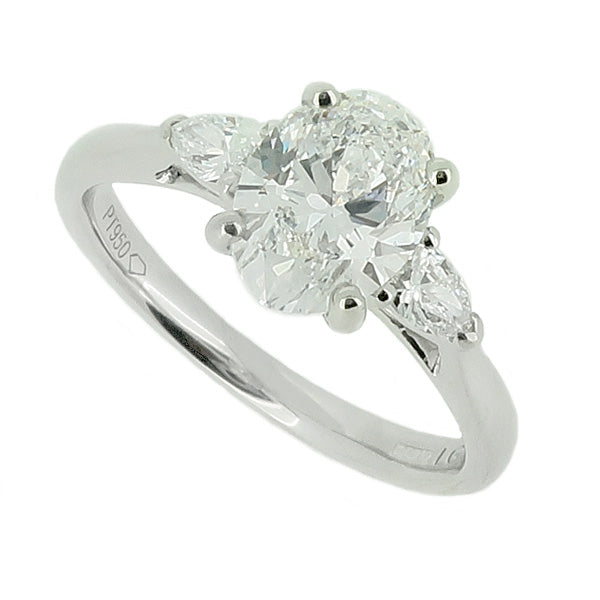Our Platinum Story

Historically, platinum has been viewed as the ‘ideal but expensive’ option for jewellery, its many practical advantages coming into conflict with a high price tag, and potential purchasers having to choose their priorities. In recent times however, the exceptionally high price of gold, coupled with a fall in the price of platinum itself, has significantly altered the situation. It is now easier than it has ever been to opt for this beautiful precious metal. So, why choose platinum?

Over the last three years, the price of platinum in GBP(£) has fallen by more than 17%, while the price of gold has risen by more than 47%. The translation of this into the price of jewellery is not straightforward, since platinum is a denser metal, so the same item will weigh more in platinum than it does in gold, but the switch has become so pronounced that platinum is now less expensive in many cases than 18ct white gold. This is a significant change, as the popularity of 18ct white gold rested almost entirely on that fact that it was less expensive than platinum.
White gold is an alloy formed of gold with metals such as silver and palladium. The alloys alter the colour of the metal to a whiter hue, but modern alloys typically have a creamy to pale yellow appearance. The metal is then rhodium plated to give the jewellery a bright white look. This plating is removed through wear, leaving the jewellery looking more yellow after a while. Rhodium plating can be re-applied to restore the bright and white finish.
Platinum is a naturally white metal and does not require any plating to enhance its colour, and the hardness of commonly used platinum alloys also means the material takes a very high polish. In addition to these aesthetic benefits, platinum also has practical advantages connected to its physical properties.

Platinum has a very high melting point of 1769°C, meaning it requires intense heat to be worked, and due to the difficulties of working it, it was not until the beginning of the twentieth century that it was used extensively in jewellery. Once the techniques existed to work platinum successfully however, it became very popular incredibly quickly.
Platinum is strong and ductile, making it perfectly suited to the creation of jewellery settings. One of the most striking differences between Victorian and Edwardian jewellery is the transition from chunky, enclosed settings to lighter, more delicate ones, due to the shift from silver to platinum allowing a smaller amount of metal to be used, while maintaining the strength of the design. It was also possible to create fine jewellery with sharply defined detail using narrow wire sections to create complex silhouettes.
Platinum is typically alloyed with other metals in order to improve its hardness, as it is naturally a relatively soft metal unsuitable for use in jewellery. The usual alloy for platinum (accounting for more than 99.5% of platinum articles hallmarked in the UK) is 95% pure platinum by weight, with 5% of the material being other metal/s, often iridium, rhodium, ruthenium, cobalt, or palladium. This is known as ‘950’ platinum. Many antique pieces are ‘900’ platinum containing slightly more of the alloyed materials.
The choice of alloying metal is important because some are more suited to particular manufacturing methods, and each has a slightly different impact on the properties of the finished piece. Many cast pieces of jewellery feature a ruthenium alloy, which raises the melting point and hardness, whitens the colour, and improves malleability and ductility. It makes for a hard and beautiful alloy that may be polished to a very high lustre.
Alloys made using iridium or palladium can be softer and, although suitable for producing handmade jewellery, because the hardness increases as the metal is worked, are not a good choice for cast pieces that require little subsequent working, as they will remain too soft.

When compared to metals such as white gold, platinum is a far more durable choice for diamond and gemstone settings. 9ct white gold in particular is often very soft, and especially for minimal designs with only small claws or grains holding the stones in place, is less suited to handling the rigours of very regular wear that we expect from our jewellery nowadays.
Often, even with yellow gold jewellery, the settings for diamonds will be produced in a white metal that complements the stones. With our 18ct gold pieces, we are now typically choosing to use platinum rather than 18ct white gold for the settings, as the price is slightly lower, and the practical benefits offered by platinum are attractive.
Platinum is also a very non-reactive metal, highly resistant to corrosion and chemical attack. Its appearance won’t be altered by contact with the most commonly encountered acids and it won’t tarnish over time. Since most platinum jewellery uses a very pure alloy, it is also a good choice of metal for those with sensitive skin. It is therefore a great option for diamond earrings.

Although generally thought of as a hard-wearing metal, it is important to keep in mind that platinum is relatively soft compared to more industrial metals (e.g. steel, titanium), and it does still scratch during wear. Most people do have their platinum jewellery polished periodically to maintain a bright shine.
With the price increasingly attractive, and the practical benefits in both durability and appearance clear, there has never been a better time to choose platinum over white gold. You can learn more about your precious metal options from one of our knowledgeable jewellers and browse both new and worn samples to aid your selection.


Comments on this post (0)